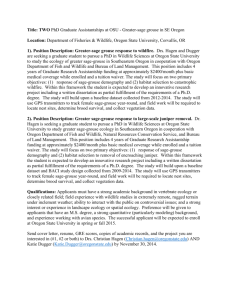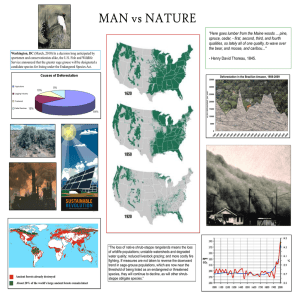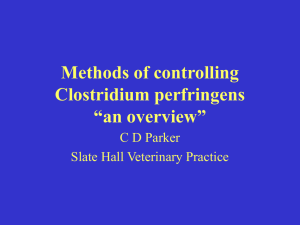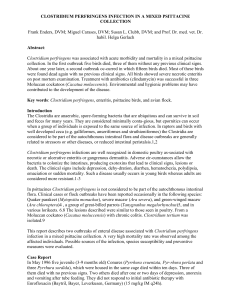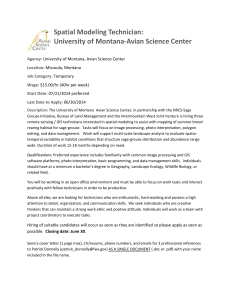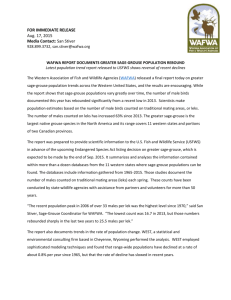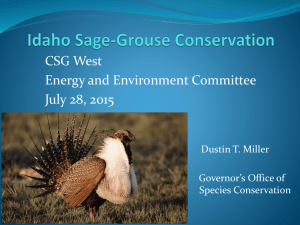An Observation of Clostridium perfringens in Greater Sage-Grouse
advertisement
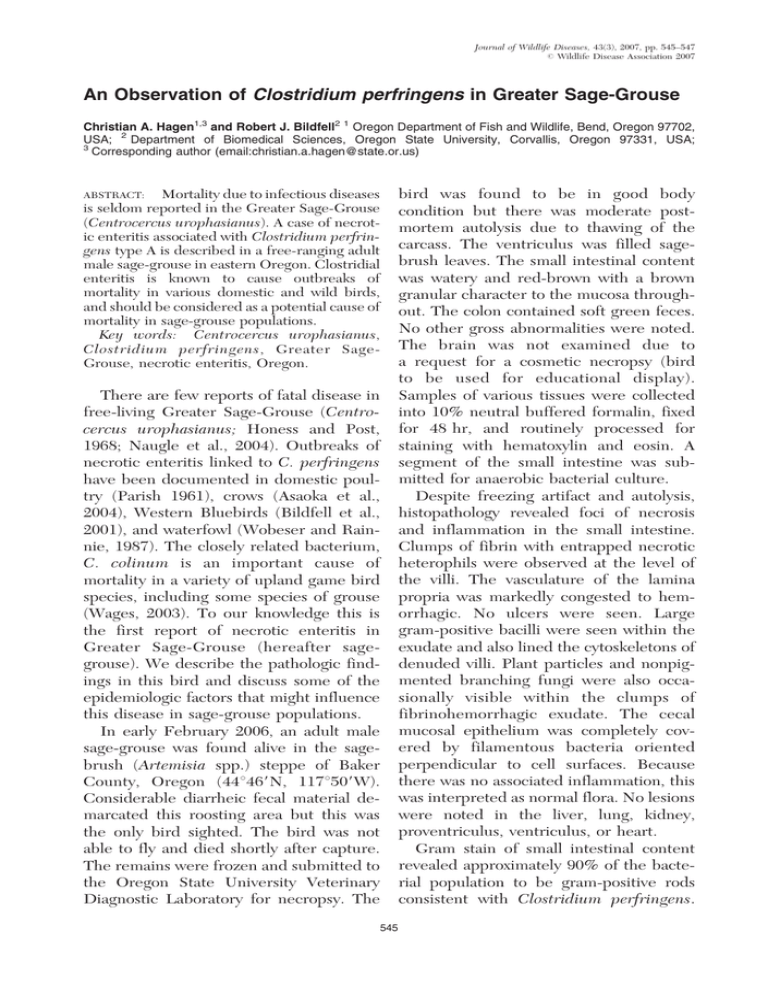
Journal of Wildlife Diseases, 43(3), 2007, pp. 545–547 # Wildlife Disease Association 2007 An Observation of Clostridium perfringens in Greater Sage-Grouse Christian A. Hagen1,3 and Robert J. Bildfell2 1 Oregon Department of Fish and Wildlife, Bend, Oregon 97702, USA; 2 Department of Biomedical Sciences, Oregon State University, Corvallis, Oregon 97331, USA; 3 Corresponding author (email:christian.a.hagen@state.or.us) bird was found to be in good body condition but there was moderate postmortem autolysis due to thawing of the carcass. The ventriculus was filled sagebrush leaves. The small intestinal content was watery and red-brown with a brown granular character to the mucosa throughout. The colon contained soft green feces. No other gross abnormalities were noted. The brain was not examined due to a request for a cosmetic necropsy (bird to be used for educational display). Samples of various tissues were collected into 10% neutral buffered formalin, fixed for 48 hr, and routinely processed for staining with hematoxylin and eosin. A segment of the small intestine was submitted for anaerobic bacterial culture. Despite freezing artifact and autolysis, histopathology revealed foci of necrosis and inflammation in the small intestine. Clumps of fibrin with entrapped necrotic heterophils were observed at the level of the villi. The vasculature of the lamina propria was markedly congested to hemorrhagic. No ulcers were seen. Large gram-positive bacilli were seen within the exudate and also lined the cytoskeletons of denuded villi. Plant particles and nonpigmented branching fungi were also occasionally visible within the clumps of fibrinohemorrhagic exudate. The cecal mucosal epithelium was completely covered by filamentous bacteria oriented perpendicular to cell surfaces. Because there was no associated inflammation, this was interpreted as normal flora. No lesions were noted in the liver, lung, kidney, proventriculus, ventriculus, or heart. Gram stain of small intestinal content revealed approximately 90% of the bacterial population to be gram-positive rods consistent with Clostridium perfringens. ABSTRACT: Mortality due to infectious diseases is seldom reported in the Greater Sage-Grouse (Centrocercus urophasianus). A case of necrotic enteritis associated with Clostridium perfringens type A is described in a free-ranging adult male sage-grouse in eastern Oregon. Clostridial enteritis is known to cause outbreaks of mortality in various domestic and wild birds, and should be considered as a potential cause of mortality in sage-grouse populations. Key words: Centrocercus urophasianus, Clostridium perfringens, Greater SageGrouse, necrotic enteritis, Oregon. There are few reports of fatal disease in free-living Greater Sage-Grouse (Centrocercus urophasianus; Honess and Post, 1968; Naugle et al., 2004). Outbreaks of necrotic enteritis linked to C. perfringens have been documented in domestic poultry (Parish 1961), crows (Asaoka et al., 2004), Western Bluebirds (Bildfell et al., 2001), and waterfowl (Wobeser and Rainnie, 1987). The closely related bacterium, C. colinum is an important cause of mortality in a variety of upland game bird species, including some species of grouse (Wages, 2003). To our knowledge this is the first report of necrotic enteritis in Greater Sage-Grouse (hereafter sagegrouse). We describe the pathologic findings in this bird and discuss some of the epidemiologic factors that might influence this disease in sage-grouse populations. In early February 2006, an adult male sage-grouse was found alive in the sagebrush (Artemisia spp.) steppe of Baker County, Oregon (44u469N, 117u509W). Considerable diarrheic fecal material demarcated this roosting area but this was the only bird sighted. The bird was not able to fly and died shortly after capture. The remains were frozen and submitted to the Oregon State University Veterinary Diagnostic Laboratory for necropsy. The 545 546 JOURNAL OF WILDLIFE DISEASES, VOL. 43, NO. 3, JULY 2007 Anaerobic culture on blood agar at 37 C yielded large numbers of C. perfringens. The genotype of a representative colony was characterized using a multiplex polymerase chain reaction technique as described by Songer and Meer (1997). The analysis revealed the isolate to be Clostridium perfringens Type A. Confirmation of C. perfringens as a cause of enteritis is difficult because the organism is a common post-mortem contaminant. The combination of very large numbers of these bacteria seen in conjunction with necrotizing and hemorrhagic intestinal lesions is strongly supportive of a diagnosis of necrotic enteritis (Wages and Opengart, 2003). A definitive diagnosis requires the demonstration of clostridial toxins from fresh samples of the intestinal content. The pathogenesis of necrotic enteritis and ulcerative enteritis involves the production of necrotizing toxins, often as a consequence of changes in the intestinal microenvironment which promote the proliferation of Clostridium species. Dietary changes or mucosal damage to the small intestine can create favorable growth conditions for these anaerobes. The latter circumstance is often linked to coccidiosis (Wobeser and Rainnie, 1987). Stuve et al. (1992) proposed C. perfringens as the causative agent of necrotizing enteritis in captive Capercaillie (Tetrao urogallus) and noted that the diet received by these Eurasian grouse was markedly different from that of their wild counterparts. Heavy contamination of the environment with clostridial spores is also likely to favor the development of necrotic enteritis or ulcerative enteritis. Stress or immunosuppression due to infections with agents such as chicken infectious anemia and infectious bursal disease are believed to be contributory in some outbreaks of necrotic enteritis in chickens (Wages and Opengart, 2003). In our observation, a change in diet is unlikely because sagebrush is the dominant component of the sage-grouse diet during winter (Remington and Braun, 1985) and this forage filled the gizzard at necropsy. Concurrent coccidiosis remains a possibility because the intestinal epithelial cell preservation in these sections was too poor to allow us to rule out such an infection. Significant mortalities have been associated with coccidiosis in sage-grouse (Honess and Post, 1968). The infective Eimeria spp. oocysts are primarily found in feces and soil. Not surprisingly, there appears to be a density dependent relationship between sage-grouse numbers and epizootics of coccidiosis (Honess and Post, 1968). In particular, die-offs of hatch-year birds have been documented in alfalfa fields and other mesic sites where large concentrations of females and their broods gather to forage in late summer (Honess and Post, 1968). Coccidiosis has not been reported to cause fatal epizootics in sage-grouse during the winter, but the elevated prevalence of Eimeria spp. oocysts in winter fecal samples (Scott, 1935) suggests a positive association with seasonal flocking behaviors of sage-grouse (Beck, 1977). We speculate that a similar phenomenon might result in larger numbers of infective Clostridium spores in winter roosting sites. The effect of pathogens at the population level is poorly understood in North American grouse species (Peterson, 2004). The recent incursion of West Nile virus into sage-grouse habitat illustrates that infectious agents have the potential to significantly affect game bird populations (Naugle et al., 2004). Natural resource agencies should consider developing monitoring programs for evaluating the role of pathogens in population dynamics of grouse and other game birds (Hagen et al., 2002). We thank Peggy Dearing, Oregon State University Veterinary Diagnostic Laboratory, for her bacteriologic expertise. D. Thee of North Powder, Oregon and G. P. Kiester, Oregon Department of Fish and Wildlife, recovered and submitted the specimen for necropsy, respectively. Ore- SHORT COMMUNICATIONS gon Department of Fish and Wildlife provided financial support of the analyses and report. LITERATURE CITED ASAOKA, Y., T. YANAI, H. HIRAYAMA, Y. UNE, E. SAITO, H. SAKAI, M. GORYO, H. FUKUSHI, AND T. MASEGI. 2004. Fatal necrotic enteritis associated with Clostridium perfringens in wild crows (Corvus macrorhynchos). Avian Pathology 33: 19–24. BECK, T. D. I. 1977. Sage grouse flock characteristics and habitat selection in winter. Journal of Wildlife Management 41: 18–26. BILDFELL, R. J., E. K. ELZROTH, AND J. G. SONGER. 2001. Enteritis as a cause of mortality in the Western bluebird (Sialia mexicana). Avian Diseases 45: 760–763. HAGEN, C. A., S. S. CRUPPER, R. D. APPLEGATE, AND R. J. ROBEL. 2002. Prevalence of Mycoplasma antibodies in lesser prairie-chicken sera. Avian Diseases 46: 708–712. HONESS, R. F., AND G. POST. 1968. History of an epizootic. Part 1: Sage grouse coccidiosis. Science Monograph 14. Sage Grouse. University of Wyoming Agricultural Experiment Station, Laramie, Wyoming, 22 pp. NAUGLE, D. E., C. L. ALDRIDGE, B. L. WALKER, T. E. CORNISH, B. J. MOYNAHAN, M. J. HOLLORAN, K. BROWN, G. D. JOHNSON, E. T. SCHMIDTMANN, R. T. MAYER, C. Y. KATO, M. R. MATCHETT, T. J. CHRISTIANSEN, W. E. COOK, T. CREEKMORE, R. D. FALISE, E. T. RINKES, AND M. S. BOYCE. 2004. West Nile virus: Pending crisis for greater sagegrouse. Ecology Letters 7: 704–713. PARISH, W. E. 1961. Necrotic enteritis in the fowl 547 (Gallus gallus domesticus) 1. Histopathology of the disease and isolation of a strain of Clostridium welchii. Journal of Comparative Pathology 71: 377–393. PETERSON, M. J. 2004. Parasites and infectious diseases of prairie grouse: Should managers be concerned? Wildlife Society Bulletin 32: 35–55. REMINGTON, T. E., AND C. E. BRAUN. 1985. Sage grouse food selection in winter, North Park, Colorado. Journal of Wildlife Management 49: 1055–1061. SCOTT, J. W. 1935. A moonlight episode in parasitology. Journal Colorado-Wyoming Academy of Science 3: 58. SONGER, J. G., AND R. R. MEER. 1997. Multiplex polymerase chain reaction assay for genotyping Clostridium perfringens. American Journal of Veterinary Research 58: 702–705. STUVE, G., M. HOFSHAGEN, AND G. HOLT. 1992. Necrotizing lesion in the intestine, gizzard, and liver in captive capercaillies (Tetrao urogallus) associated with Clostridium perfringens. Journal of Wildlife Diseases 28: 598–602. WAGES, D. P. 2003. Ulcerative enteritis (quail disease). In Diseases of poultry, 11th Edition, Y. Saif (ed.). Iowa State Press, Ames Iowa, pp. 776–81. ———, AND K. OPENGART. 2003. Necrotic enteritis. In Diseases of poultry, 11th Edition, Y. Saif (ed.). Iowa State Press, Ames Iowa, pp. 781–785. WOBESER, G., AND D. J. RAINNIE. 1987. Epizootic necrotic enteritis in wild geese. Journal of Wildlife Diseases 23: 376–385. Received for publication 13 September 2006.
